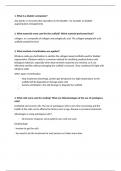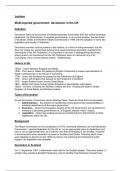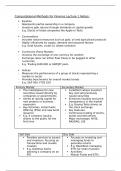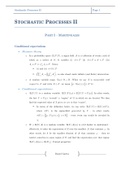A new destination with a new engine
Block Assignment 5: Performance
FT_AV2E-1
student
student student
Student Student
Student
,Picture source: …….. 08/09/2021
Starting date:
01/09/2021
Due date:
03/11/2021
Consultants:
2
, Summary
KLM wants to increase their route network to Latin America. The problem is that the Airbus A330-
200’s that are used for this are not able to reach Panama City Airport at the desired range of 4.762.
Furthermore, the take-off performance at maximum take-off mass is insufficient to take-off from
Panama City. A solution to this is modifying the engine. By modifying the engine, or making it more
efficient, less fuel is being consumed. With the modification the A330-200 can fly the route to the
chosen destination in Latin-America.
To obtain the needed performance, several key engine parameters need to be improved. The thrust
specific fuel consumption (TSFC) is one of those key parameters. By using carbon fiber composites in
the fan and a more efficient fuel burning process, the TSFC can be improved by more than 10%.
Furthermore, by looking at available airports for the A330-200 to fly to, the other key parameters for
the modified engine can be determined. This results in a possibility for the A330-200 to take off from
Amsterdam Schiphol and fly to Latin America.
With the needed performance and several key engine parameters known, flight planning and
performance manual (FPPM) for each flight stage can be made. This FPPM contains tables with all
known and calculated engine values, and therefore gives an overview of what the aircraft with the
modified engine can do.
With the use of internet sources and studies, it is known which parameters can be changed to improve
the engine’s performance. These parameters include the bypass pressure ratio (BPR), fan pressure
ratio (FPR), the core pressure ratio (CPR), the turbine inlet temperature (TIT) and several efficiencies
throughout the engine. By balancing the values, whilst including the carbon fiber composites and
FADEC system, the right TSFC is calculated with feasible parameters to fly with.
After finding the right airport, and changing the parameters of the modified engine, it becomes
possible for the A330-200 to fly from Amsterdam Schiphol to the chosen airport. Therefore, the
modification can take place and flying a route with the A330-200 with a modified engine to Latin
America can be done.
In conclusion, to get the right performance to reach Panama City Airport with MTOM at a distance of
4.762 nautical miles, the key engine parameters advised to be changed are the mass flow, the BPR,
the FPR, the CPRldc, the CPRldhc, the TIT and several efficiencies throughout the GE-90 engine.
3
, Symbols list
Symbol Description SI-Unit
a Speed of Sound [m/s]
b Wingspan [m]
c vertical speed [m/s]
CD Drag coefficient [-]
CD0 Parasitic drag coefficient [-]
CDI induced drag coefficient [-]
CL Lift coefficient [-]
CT Specific Fuel consumption [N/(n*s)]
D Drag [N]
e Oswald factor [-]
Fb Thrust produces by the bypass [N]
FC Thrust produces by the core [N]
Ftot Total thrust [N}
g Gravitational force on earth [9,81]
h Altitude [m]
L Lift [N]
m Mass [Kg]
Mf Mass flow [kg/s]
Pcr Critical pressure [Pa]
Pcr,cold Critical pressure of cold air [Pa]
Pcr,hot Critical pressure of hot air [Pa]
Rs specific gas constant [J/kg/K]
Rs,air Specific gas constant for dry air [J/(kg*K)]
Rs,gas Specific gas constant for gas [J/(kg*K)]
S Wing Surface [m2]
SAT Static air temperature [K]
T Temperature [K]
T Thrust [N]
t Time [s]
T0 Temperature at sea level [K]
Th Temperature at altitude [K]
Tmax Temperature max [K}
Treq Required thrust alt altitude [N]
v Velocity [m/s]
y Heat capacity of air or gas [-]
ymax Maximum climb angle [ft/min]
ymin Minimum glide angle [ft/min]
ΔH Different altitude [m]
ƞf Fan polytropic efficiency [-]
ƞi Intake efficiency [-]
ƞu,fan Isentropic nozzle efficiency [-]
p0 Density on sea level [kg/m3]
ph Density at height (h) [kg/m3]
4
Block Assignment 5: Performance
FT_AV2E-1
student
student student
Student Student
Student
,Picture source: …….. 08/09/2021
Starting date:
01/09/2021
Due date:
03/11/2021
Consultants:
2
, Summary
KLM wants to increase their route network to Latin America. The problem is that the Airbus A330-
200’s that are used for this are not able to reach Panama City Airport at the desired range of 4.762.
Furthermore, the take-off performance at maximum take-off mass is insufficient to take-off from
Panama City. A solution to this is modifying the engine. By modifying the engine, or making it more
efficient, less fuel is being consumed. With the modification the A330-200 can fly the route to the
chosen destination in Latin-America.
To obtain the needed performance, several key engine parameters need to be improved. The thrust
specific fuel consumption (TSFC) is one of those key parameters. By using carbon fiber composites in
the fan and a more efficient fuel burning process, the TSFC can be improved by more than 10%.
Furthermore, by looking at available airports for the A330-200 to fly to, the other key parameters for
the modified engine can be determined. This results in a possibility for the A330-200 to take off from
Amsterdam Schiphol and fly to Latin America.
With the needed performance and several key engine parameters known, flight planning and
performance manual (FPPM) for each flight stage can be made. This FPPM contains tables with all
known and calculated engine values, and therefore gives an overview of what the aircraft with the
modified engine can do.
With the use of internet sources and studies, it is known which parameters can be changed to improve
the engine’s performance. These parameters include the bypass pressure ratio (BPR), fan pressure
ratio (FPR), the core pressure ratio (CPR), the turbine inlet temperature (TIT) and several efficiencies
throughout the engine. By balancing the values, whilst including the carbon fiber composites and
FADEC system, the right TSFC is calculated with feasible parameters to fly with.
After finding the right airport, and changing the parameters of the modified engine, it becomes
possible for the A330-200 to fly from Amsterdam Schiphol to the chosen airport. Therefore, the
modification can take place and flying a route with the A330-200 with a modified engine to Latin
America can be done.
In conclusion, to get the right performance to reach Panama City Airport with MTOM at a distance of
4.762 nautical miles, the key engine parameters advised to be changed are the mass flow, the BPR,
the FPR, the CPRldc, the CPRldhc, the TIT and several efficiencies throughout the GE-90 engine.
3
, Symbols list
Symbol Description SI-Unit
a Speed of Sound [m/s]
b Wingspan [m]
c vertical speed [m/s]
CD Drag coefficient [-]
CD0 Parasitic drag coefficient [-]
CDI induced drag coefficient [-]
CL Lift coefficient [-]
CT Specific Fuel consumption [N/(n*s)]
D Drag [N]
e Oswald factor [-]
Fb Thrust produces by the bypass [N]
FC Thrust produces by the core [N]
Ftot Total thrust [N}
g Gravitational force on earth [9,81]
h Altitude [m]
L Lift [N]
m Mass [Kg]
Mf Mass flow [kg/s]
Pcr Critical pressure [Pa]
Pcr,cold Critical pressure of cold air [Pa]
Pcr,hot Critical pressure of hot air [Pa]
Rs specific gas constant [J/kg/K]
Rs,air Specific gas constant for dry air [J/(kg*K)]
Rs,gas Specific gas constant for gas [J/(kg*K)]
S Wing Surface [m2]
SAT Static air temperature [K]
T Temperature [K]
T Thrust [N]
t Time [s]
T0 Temperature at sea level [K]
Th Temperature at altitude [K]
Tmax Temperature max [K}
Treq Required thrust alt altitude [N]
v Velocity [m/s]
y Heat capacity of air or gas [-]
ymax Maximum climb angle [ft/min]
ymin Minimum glide angle [ft/min]
ΔH Different altitude [m]
ƞf Fan polytropic efficiency [-]
ƞi Intake efficiency [-]
ƞu,fan Isentropic nozzle efficiency [-]
p0 Density on sea level [kg/m3]
ph Density at height (h) [kg/m3]
4











